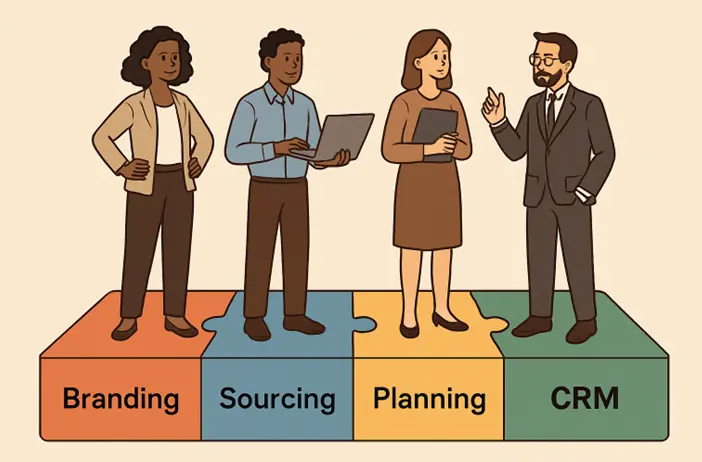Understanding Talent Acquisition
Talent acquisition is a comprehensive and strategic discipline that extends beyond the transactional process of recruitment. It focuses on identifying, attracting, and ultimately retaining professionals whose skills and values directly support organizational ambitions. This approach requires long-term vision—rather than simply filling immediate vacancies, talent acquisition cultivates a talent pipeline that aligns with the company’s future growth and agility needs. For organizations interested in learning more about the role of talent acquisition, it’s clear this function is critical to sustainable success.
Unlike traditional recruitment, which tends to react to personnel gaps, talent acquisition is proactive and tightly woven into company strategy. It is an ongoing process—a partnership between leadership, hiring managers, and human resources—that ensures the right people are brought in to drive innovation, efficiency, and a strong company culture.
Key Components of Effective Talent Acquisition
- Employer Branding: Developing a compelling employer brand is foundational to success. It communicates the organization’s culture, mission, and values to the external world. A strong employer brand differentiates a company in a competitive job market, attracting high-quality candidates who are excited about the organization’s purpose and workplace environment. For more insights on shaping an effective employer brand, resources like HR Dive’s guide on building a successful talent acquisition strategyprovide valuable strategies.
- Proactive Sourcing: Proactive sourcing involves building relationships with potential candidates before a specific role becomes available. These efforts may include attending industry events, establishing talent networks, and leveraging social media platforms to identify and engage with top talent. A robust talent pipeline ensures that organizations can respond to new opportunities and challenges swiftly.
- Workforce Planning: Strategic workforce planning aligns hiring practices with the company’s operational and long-term goals. By anticipating future talent needs and skill gaps, organizations are better equipped to scale, adapt to market changes, and innovate.
- Candidate Relationship Management (CRM): Sustained engagement with potential candidates, even if they aren’t ready to make a career move immediately, creates goodwill and keeps the organization top-of-mind. CRM platforms enable personalized outreach and nurture long-term interest among prospects.
Aligning Talent Acquisition with Business Strategy
For talent acquisition to add real value, it must be seamlessly integrated with the overall business strategy. Understanding the company’s vision and planned trajectory allows talent leaders to recruit for both immediate requirements and anticipated competencies. For example, if a business plans geographic or product expansion, talent acquisition should prioritize candidates with relevant market insight, language proficiency, or technical expertise. As noted in Forbes’ insights on aligning talent and business goals, this deliberate alignment ensures that every new hire actively contributes to achieving the company’s milestones and future direction. By continually evaluating hiring practices against strategic objectives, organizations can remain agile in a changing business environment. This approach also promotes stronger collaboration between HR and executive leadership, ensuring that workforce planning directly supports long-term growth. Ultimately, aligning talent strategies with business goals builds a resilient, future-ready organization that can adapt and thrive.
Leveraging Technology in Talent Acquisition
Digital transformation has revolutionized how organizations approach sourcing and hiring. Applicant Tracking Systems (ATS) automate much of the recruitment workflow, from posting jobs and sorting resumes to scheduling interviews and collecting feedback. Artificial intelligence is another key enabler, capable of sifting through vast amounts of data to recommend top candidates, identify potential skill gaps, and forecast hiring trends. These technologies not only accelerate the hiring process but also help reduce unconscious biases and enhance the accuracy of matching candidates to organizational needs. By integrating advanced tools into their talent acquisition strategies, companies can benefit from enhanced efficiency and data-driven decision-making.
Emphasizing Diversity and Inclusion
A diverse and inclusive workforce brings together a broader range of viewpoints, strengthening creativity, problem-solving, and business performance. Embedding diversity, equity, and inclusion (DEI) into every stage of talent acquisition yields better hiring outcomes. Organizations can foster equity by crafting unbiased job descriptions, investing in interviewer training to mitigate biases, and proactively sourcing from historically underrepresented talent pools. This commitment to DEI not only fulfills social and ethical obligations but also expands access to top-tier talent from a wider range of backgrounds.
Measuring Success in Talent Acquisition
The effectiveness of talent acquisition should be evaluated through a set of key performance indicators (KPIs). Core metrics include time-to-fill (the duration from job posting to hire), quality of hire (performance and retention of new employees), and candidate experience scores. Regular analysis of these figures highlights what’s working and where there’s room for improvement, enabling HR teams to make informed adjustments that optimize results and support evolving business objectives.
Conclusion
Talent acquisition is a dynamic, strategic function that drives organizational strength and future growth. By investing in branding, proactive sourcing, and modern technologies—while embracing diversity and regularly refining the process through analytics—companies can secure, develop, and retain the high-caliber talent necessary for sustainable success in an ever-evolving business landscape.
ALSO READ-How Reliable Backup Power Solutions Can Support Everyday Life
